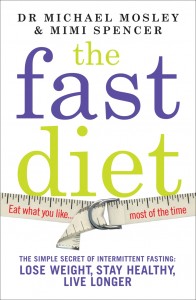 It is fair to say that there are several times of year that really make us think about weight – in the New Year as part of resolutions having indulged in lots of food and drink over Christmas and in the summer when the weather is making us shake off our layers and think about bearing all in our swimming costumes!
It is fair to say that there are several times of year that really make us think about weight – in the New Year as part of resolutions having indulged in lots of food and drink over Christmas and in the summer when the weather is making us shake off our layers and think about bearing all in our swimming costumes!
Along with these changing seasons it is also fair to say that there is always a new diet on the block, low fat, low carb, blood type, Atkins, Dukan – you name it…But now there is a new kid on the block with the catchy name of Intermittent Fasting, hot on the trend several books have been published and well publicised with television programmes, newspaper articles and shop presence. Such as The 5:2 Diet Book, The 2 Day Diet and The Fast Diet, all based on the same premise of fasting for two days and eating normally for the other five to achieve weight loss and a whole host of other benefits.
But just what does intermittent fasting mean, how do you do it and does it work?
The interest in this type of diet in the UK really took off following the airing of a Horizon programme called Eat, Fast and Live Longer, Dr Michael Mosley who is a medical journalist went on a journey for the programme investigating the effects and health benefits of two things – Intermittent Fasting and Calorie Restriction. Fasting used to mean just that, eating nothing for a period of time sustaining yourself just on water, but now it has come to mean eating around 25% of your recommended calorie intake on some days. Calorie restriction is followed by some people who believe that reducing their calorie intake on a daily basis by about 30% in the long term provides a healthier and longer life.
In the programme a number of types of fasting were explored and tried by Michael: Option 1 – a four day fast, exactly as it sounds, eating nothing but a cup-a-soup and water for 4 days, this option should be repeated every couple of months for lasting benefits. Option 2 – Alternate day fasting, so eating normally one day and with no food or limited food on the alternate days, effective but hard to live with in the long term. Option 3 – intermittent fasting; eating for five days normally and fasting on two days a week. This gives many of the same health benefits and weight loss, but is easier to incorporate in to everyday life and can be maintained in the long term.
Following the programme Michael teamed up with Mimi Spencer an award-winning food and fashion writer and together they launched The Fast Diet. In it they recommend that you eat normally for five days of the week and on the other two you restrict your calorie intake to 500 if you are a woman and 600 if you are a man. They claim that this approach reduces weight, and lowers your risk of diabetes, heart disease and cancer.
The 2-Day Diet works along the same lines; it was developed by scientists Dr Michelle Harvie and Prof Tony Howell at Genesis Breast Cancer Prevention (all author proceeds go to this charity). They believe that this was the original 5/2 diet and that it is clinically proven. On their two fasting day’s food intake should be low carbohydrate. Additional benefits are noted as lowering high blood pressure, anti-ageing effects, improved mood, increased energy levels and general well-being.
Lastly the 5:2 Diet; written by Kate Harrison a journalist and former yoyo dieter. This book works on the same premise and offers up health benefits such as having positive effects on Alzheimer’s.
Most of the diets have follow up recipe books to help you create delicious but low calorie meals to maximise your 500/600 calories or so a day. Reviewers on websites have sung the praises of such a sensible and manageable approach and it has picked up some unlikely celebrities followers along the way – such as Hugh Fearnley-Whittingstall who started on such a plan in the New Year with a 250 calorie breakfast and 350 calorie supper and quickly lost 8lbs!
Tweet